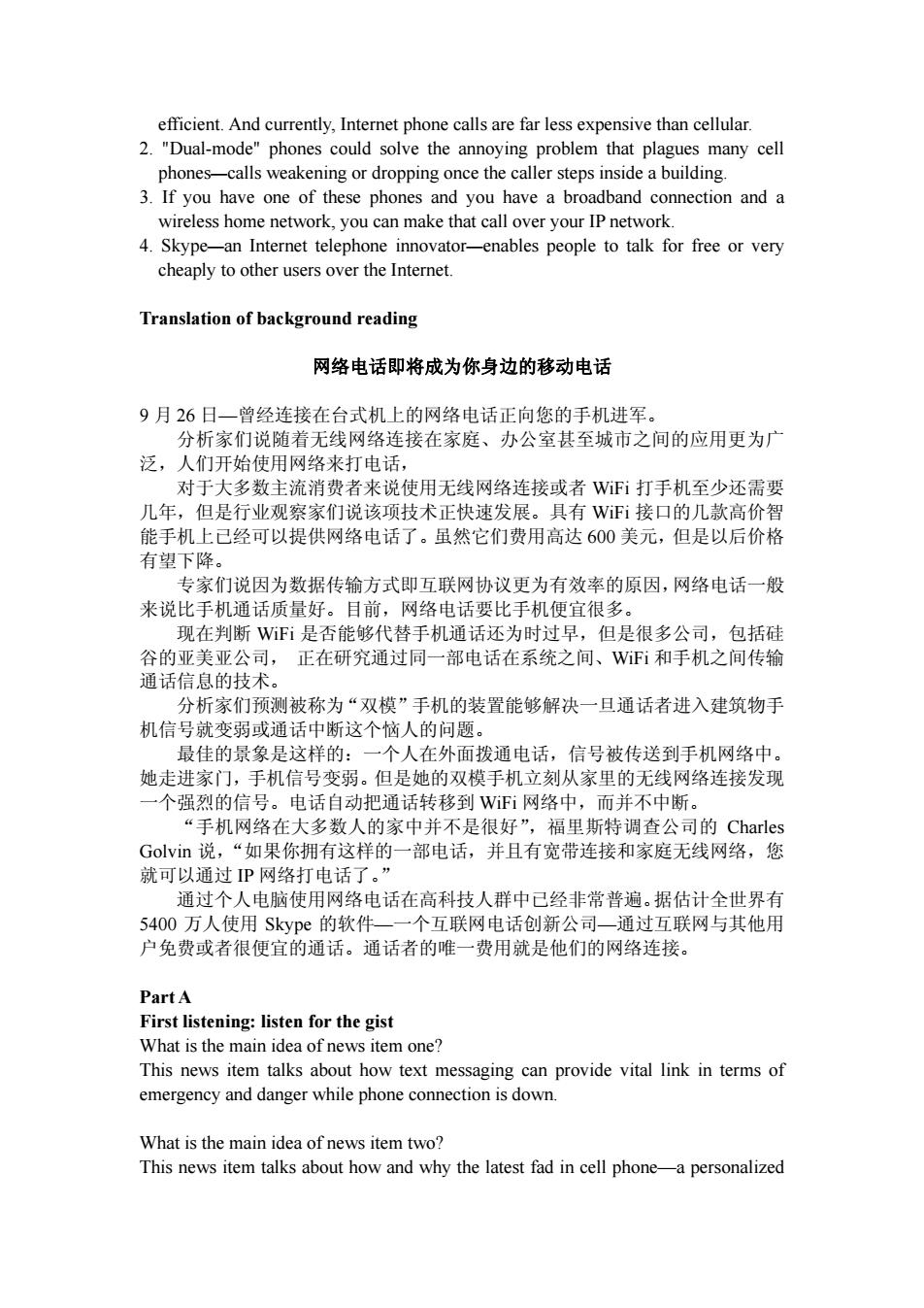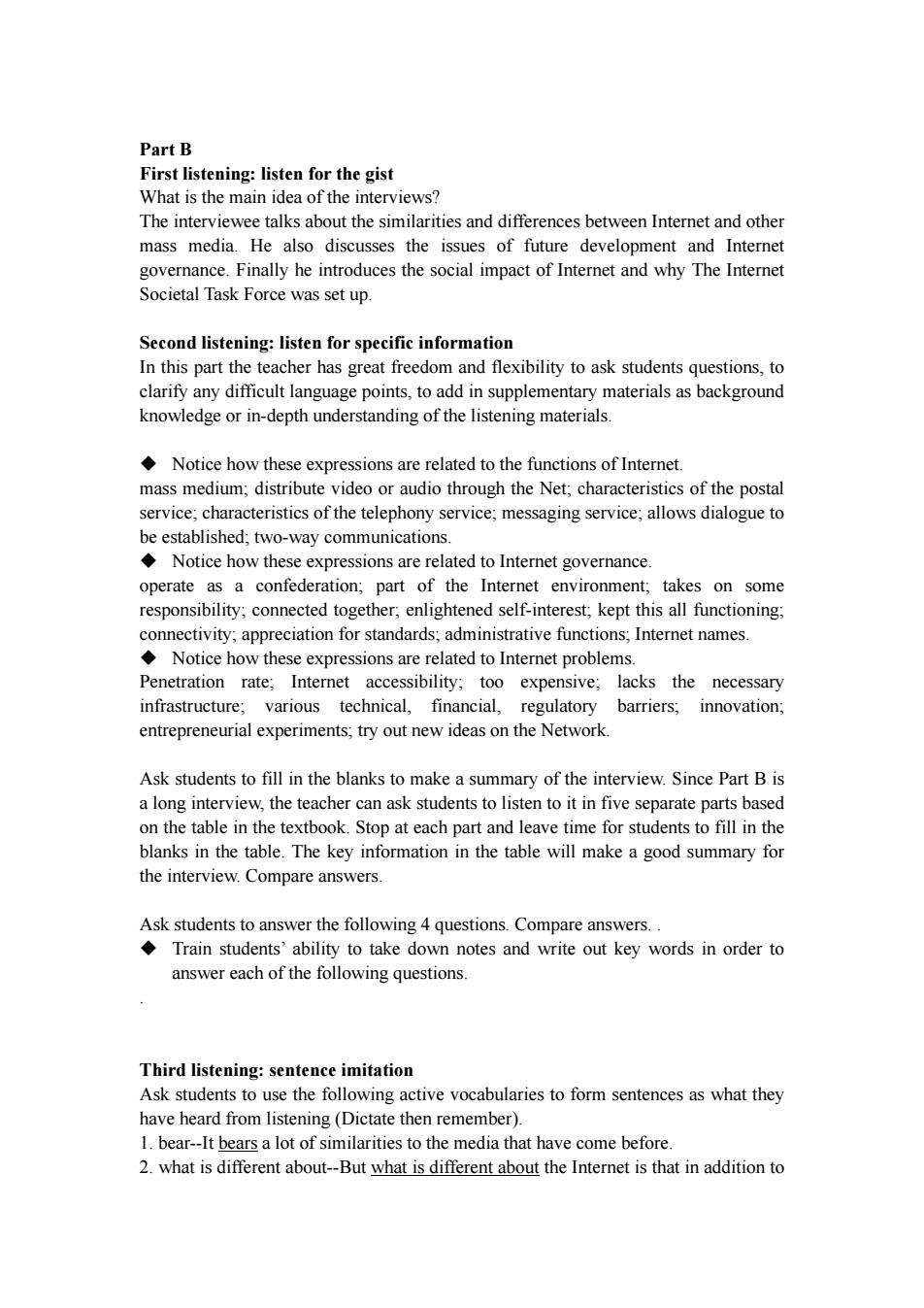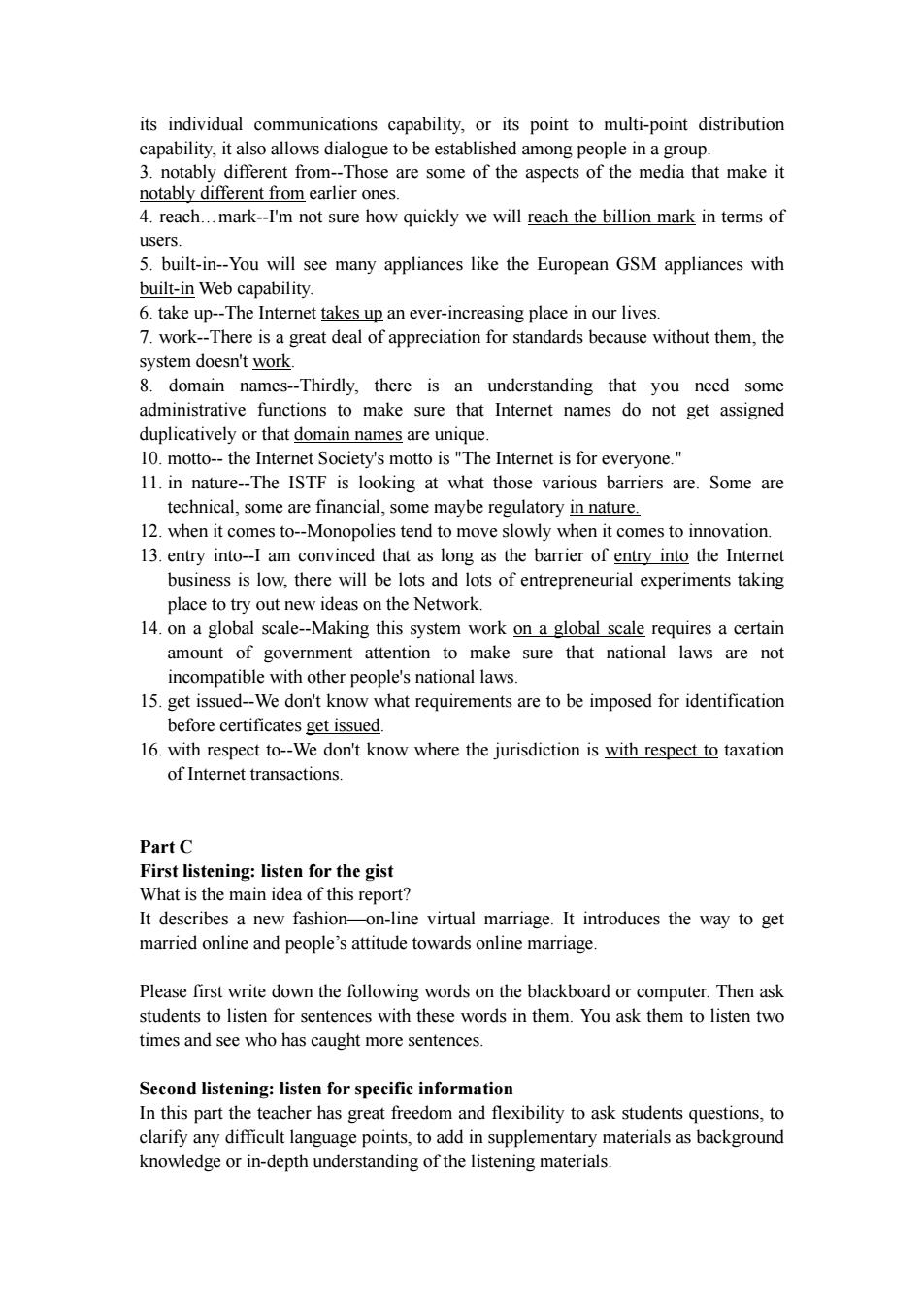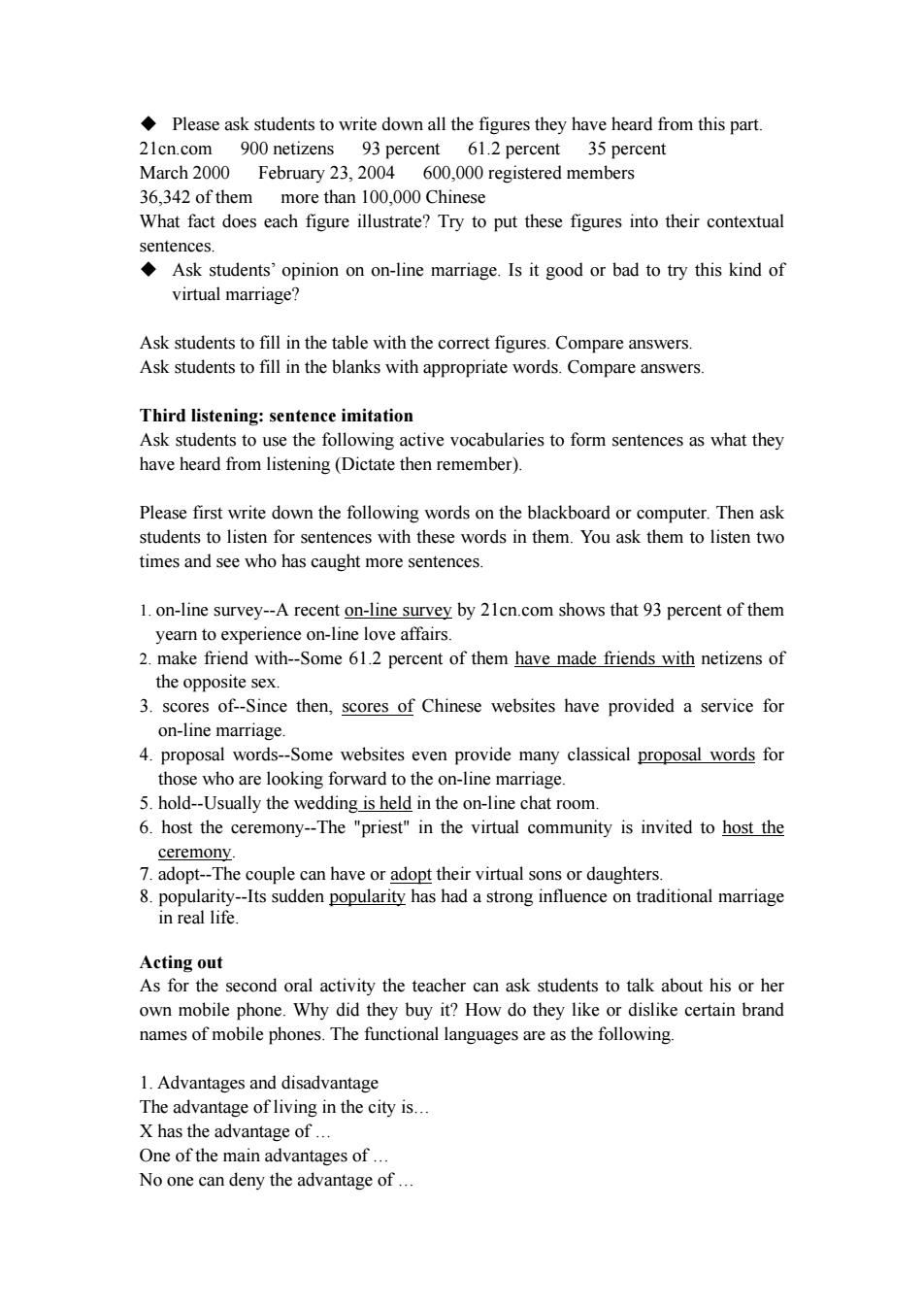
Unit 17 Get Yourself Wired-Internet and Mobile Phones 连线时代一互联网与移动电话 √Learning objectives 1.In this unit students will learn words and expressions related to Internet and mobile phones. 2.Students will be able to talk about the advantages and disadvantages of Internet and mobile phones. Background reading Notes: 1.tether用绳或链栓住 tether sth(to sth)to fasten (an animal)with a tether He tethered his horse to a tree. Internet phone calls,once tethered to desktop computers,are heading for your mobile phones. 3.heading for向(某处)行进 head for move towards(a place) He headed straight for the bar.The boat was heading for some rocks. 4.mainstream主流;倾向,趋势 For most mainstream consumers in China,using credit cards to pay is at least a couple of years away 5.WiFi 6.Internet Protocol互联网协议(简称IP),是TCP(Transmission Control Protocol 传输控制协议)P协议中的网络层协议,用于为数据从它的始发地到目的地 选择路径。 7.dual-mode双模式手机(既有手机信号又有互联网信号) 8.plague给某人造成麻烦或困扰,烦扰某人 plague cause trouble or difficulty to(sb/sth) The dual-mode phones could solve the annoying problem that plagues many mobile phone users. 9.tech-savvy set对技术懂行,了解的人群 savvy common sense,understanding Where is your savvy? Answers to comprehension questions: 1.Experts say that Internet calls are generally of better quality than cell phone calls because the way data is transferred,known as the Internet Protocol,is more
Unit 17 Get Yourself Wired—Internet and Mobile Phones 连线时代—互联网与移动电话 3 Learning objectives 1. In this unit students will learn words and expressions related to Internet and mobile phones. 2. Students will be able to talk about the advantages and disadvantages of Internet and mobile phones. Background reading Notes: 1. tether 用绳或链栓住 tether sth (to sth) to fasten (an animal) with a tether He tethered his horse to a tree. Internet phone calls, once tethered to desktop computers, are heading for your mobile phones. 3. heading for 向(某处)行进 head for move towards (a place) He headed straight for the bar. The boat was heading for some rocks. 4. mainstream 主流;倾向,趋势 For most mainstream consumers in China, using credit cards to pay is at least a couple of years away. 5. WiFi 6. Internet Protocol 互联网协议(简称IP),是TCP (Transmission Control Protocol 传输控制协议)/IP 协议中的网络层协议,用于为数据从它的始发地到目的地 选择路径。 7. dual-mode 双模式手机(既有手机信号又有互联网信号) 8. plague 给某人造成麻烦或困扰,烦扰某人 plague cause trouble or difficulty to (sb/sth) The dual-mode phones could solve the annoying problem that plagues many mobile phone users. 9. tech-savvy set 对技术懂行,了解的人群 savvy common sense, understanding Where is your savvy? Answers to comprehension questions: 1. Experts say that Internet calls are generally of better quality than cell phone calls because the way data is transferred, known as the Internet Protocol, is more

efficient.And currently,Internet phone calls are far less expensive than cellular. 2."Dual-mode"phones could solve the annoying problem that plagues many cell phones-calls weakening or dropping once the caller steps inside a building. 3.If you have one of these phones and you have a broadband connection and a wireless home network,you can make that call over your IP network. 4.Skype-an Internet telephone innovator-enables people to talk for free or very cheaply to other users over the Internet. Translation of background reading 网络电话即将成为你身边的移动电话 9月26日一曾经连接在台式机上的网络电话正向您的手机进军。 分析家们说随着无线网络连接在家庭、办公室甚至城市之间的应用更为广 泛,人们开始使用网络来打电话, 对于大多数主流消费者来说使用无线网络连接或者WF打手机至少还需要 几年,但是行业观察家们说该项技术正快速发展。具有WFi接口的几款高价智 能手机上己经可以提供网络电话了。虽然它们费用高达600美元,但是以后价格 有望下降。 专家们说因为数据传输方式即互联网协议更为有效率的原因,网络电话一般 来说比手机通话质量好。目前,网络电话要比手机便宜很多。 现在判断WFi是否能够代替手机通话还为时过早,但是很多公司,包括硅 谷的亚美亚公司,正在研究通过同一部电话在系统之间、WFi和手机之间传输 通话信息的技术。 分析家们预测被称为“双模”手机的装置能够解决一旦通话者进入建筑物手 机信号就变弱或通话中断这个恼人的问题。 最佳的景象是这样的:一个人在外面拨通电话,信号被传送到手机网络中。 她走进家门,手机信号变弱。但是她的双模手机立刻从家里的无线网络连接发现 一个强烈的信号。电话自动把通话转移到WFi网络中,而并不中断。 “手机网络在大多数人的家中并不是很好”,福里斯特调查公司的Charles Golvin说,“如果你拥有这样的一部电话,并且有宽带连接和家庭无线网络,您 就可以通过P网络打电话了。” 通过个人电脑使用网络电话在高科技人群中已经非常普遍。据估计全世界有 5400万人使用Skype的软件一一个互联网电话创新公司一通过互联网与其他用 户免费或者很便宜的通话。通话者的唯一费用就是他们的网络连接。 PartA First listening:listen for the gist What is the main idea of news item one? This news item talks about how text messaging can provide vital link in terms of emergency and danger while phone connection is down. What is the main idea of news item two? This news item talks about how and why the latest fad in cell phone-a personalized
efficient. And currently, Internet phone calls are far less expensive than cellular. 2. "Dual-mode" phones could solve the annoying problem that plagues many cell phones—calls weakening or dropping once the caller steps inside a building. 3. If you have one of these phones and you have a broadband connection and a wireless home network, you can make that call over your IP network. 4. Skype—an Internet telephone innovator—enables people to talk for free or very cheaply to other users over the Internet. Translation of background reading 网络电话即将成为你身边的移动电话 9 月 26 日—曾经连接在台式机上的网络电话正向您的手机进军。 分析家们说随着无线网络连接在家庭、办公室甚至城市之间的应用更为广 泛,人们开始使用网络来打电话, 对于大多数主流消费者来说使用无线网络连接或者 WiFi 打手机至少还需要 几年,但是行业观察家们说该项技术正快速发展。具有 WiFi 接口的几款高价智 能手机上已经可以提供网络电话了。虽然它们费用高达 600 美元,但是以后价格 有望下降。 专家们说因为数据传输方式即互联网协议更为有效率的原因,网络电话一般 来说比手机通话质量好。目前,网络电话要比手机便宜很多。 现在判断 WiFi 是否能够代替手机通话还为时过早,但是很多公司,包括硅 谷的亚美亚公司, 正在研究通过同一部电话在系统之间、WiFi 和手机之间传输 通话信息的技术。 分析家们预测被称为“双模”手机的装置能够解决一旦通话者进入建筑物手 机信号就变弱或通话中断这个恼人的问题。 最佳的景象是这样的:一个人在外面拨通电话,信号被传送到手机网络中。 她走进家门,手机信号变弱。但是她的双模手机立刻从家里的无线网络连接发现 一个强烈的信号。电话自动把通话转移到 WiFi 网络中,而并不中断。 “手机网络在大多数人的家中并不是很好”,福里斯特调查公司的 Charles Golvin 说,“如果你拥有这样的一部电话,并且有宽带连接和家庭无线网络,您 就可以通过 IP 网络打电话了。” 通过个人电脑使用网络电话在高科技人群中已经非常普遍。据估计全世界有 5400 万人使用 Skype 的软件—一个互联网电话创新公司—通过互联网与其他用 户免费或者很便宜的通话。通话者的唯一费用就是他们的网络连接。 Part A First listening: listen for the gist What is the main idea of news item one? This news item talks about how text messaging can provide vital link in terms of emergency and danger while phone connection is down. What is the main idea of news item two? This news item talks about how and why the latest fad in cell phone—a personalized

“ringback”tone service came into being Second listening:listen for specific information In this part the teacher has great freedom and flexibility to ask students questions,to clarify any difficult language points,to add in supplementary materials as background knowledge or in-depth understanding of the listening materials. Notice how these expressions are related to cell phones. text message;voice service;short messaging service;cell network;continuous connection;network's resources;standard ring;ringback tone;game downloads, ringtones;news clips;personalization for cell phones;communicate identity. Notice how these expressions are related to disasters. hurricane-damaged outlets;hurricane Katrina;terrorist bombing;a personal tool for survival;a widespread disaster;(landslide,earthquake,Tsunami,mine explosion, tornado,Taifeng,flood,snow storm,fire) Ask students to do multiple choices questions in news item one.Compare answers. Ask students to do True (T)or False (F)questions for news item two.Compare answers.Explain why it is true or false and find evidence to support.. Third listening:sentences imitation Ask students to use the following active vocabularies to form sentences as what they have heard from listening(Dictate then remember). 1.thanks to--A New Orleans juice-bar company hopes to reopen at least five of its hurricane-damaged outlets this week,thanks to employees who were able to use text messages to arrange cleanups and the delivery of fresh supplies. 2.transmit--Text messaging,also known as short messaging service,or "SMS,"uses the same cellular networks that transmit millions of telephone calls daily. 3.go through--But text messages,which are limited to 160 alphanumeric characters, are more likely to go through even when voice traffic gets congested. 4.get in touch with--Text messaging can be a personal tool for survival to get in touch with loved ones or others after a widespread disaster. 5.instead of--The next time you call a friend's cell phone,instead of listening to the standard ring,you might hear Alicia Keys crooning "A Woman's Worth." 6.the latest fad--Personalized "ringback tones"that replace the standard ringing sound a caller hears are the latest fad in cell phones. 7.recoup--Hoping to recoup lost revenue,carriers are offering more products and services,such as game downloads,ringtones and news clips. 8.partner with--Both Verizon and T-Mobile have partnered with large recording companies. 9.gear to--The idea is geared to 14-to 28-year-olds
“ringback” tone service came into being. Second listening: listen for specific information In this part the teacher has great freedom and flexibility to ask students questions, to clarify any difficult language points, to add in supplementary materials as background knowledge or in-depth understanding of the listening materials. Notice how these expressions are related to cell phones. text message; voice service; short messaging service; cell network; continuous connection; network's resources; standard ring; ringback tone; game downloads, ringtones; news clips; personalization for cell phones; communicate identity. Notice how these expressions are related to disasters. hurricane-damaged outlets; hurricane Katrina; terrorist bombing; a personal tool for survival; a widespread disaster; (landslide, earthquake, Tsunami, mine explosion, tornado, Taifeng, flood, snow storm, fire) Ask students to do multiple choices questions in news item one. Compare answers. Ask students to do True (T) or False (F) questions for news item two. Compare answers. Explain why it is true or false and find evidence to support.. Third listening: sentences imitation Ask students to use the following active vocabularies to form sentences as what they have heard from listening (Dictate then remember). 1. thanks to--A New Orleans juice-bar company hopes to reopen at least five of its hurricane-damaged outlets this week, thanks to employees who were able to use text messages to arrange cleanups and the delivery of fresh supplies. 2. transmit--Text messaging, also known as short messaging service, or "SMS," uses the same cellular networks that transmit millions of telephone calls daily. 3. go through-- But text messages, which are limited to 160 alphanumeric characters, are more likely to go through even when voice traffic gets congested. 4. get in touch with--Text messaging can be a personal tool for survival to get in touch with loved ones or others after a widespread disaster. 5. instead of--The next time you call a friend's cell phone, instead of listening to the standard ring, you might hear Alicia Keys crooning "A Woman's Worth." 6. the latest fad--Personalized "ringback tones" that replace the standard ringing sound a caller hears are the latest fad in cell phones. 7. recoup--Hoping to recoup lost revenue, carriers are offering more products and services, such as game downloads, ringtones and news clips. 8. partner with--Both Verizon and T-Mobile have partnered with large recording companies. 9. gear to--The idea is geared to 14- to 28-year-olds

Part B First listening:listen for the gist What is the main idea of the interviews? The interviewee talks about the similarities and differences between Internet and other mass media.He also discusses the issues of future development and Internet governance.Finally he introduces the social impact of Internet and why The Internet Societal Task Force was set up. Second listening:listen for specific information In this part the teacher has great freedom and flexibility to ask students questions,to clarify any difficult language points,to add in supplementary materials as background knowledge or in-depth understanding of the listening materials. Notice how these expressions are related to the functions of Internet. mass medium;distribute video or audio through the Net;characteristics of the postal service;characteristics of the telephony service;messaging service;allows dialogue to be established;two-way communications. Notice how these expressions are related to Internet governance. operate as a confederation;part of the Internet environment;takes on some responsibility;connected together;enlightened self-interest;kept this all functioning; connectivity;appreciation for standards;administrative functions;Internet names. Notice how these expressions are related to Internet problems. Penetration rate;Internet accessibility;too expensive;lacks the necessary infrastructure;various technical,financial,regulatory barriers;innovation; entrepreneurial experiments;try out new ideas on the Network. Ask students to fill in the blanks to make a summary of the interview.Since Part B is a long interview,the teacher can ask students to listen to it in five separate parts based on the table in the textbook.Stop at each part and leave time for students to fill in the blanks in the table.The key information in the table will make a good summary for the interview.Compare answers. Ask students to answer the following 4 questions.Compare answers.. Train students'ability to take down notes and write out key words in order to answer each of the following questions. Third listening:sentence imitation Ask students to use the following active vocabularies to form sentences as what they have heard from listening(Dictate then remember). 1.bear--It bears a lot of similarities to the media that have come before. 2.what is different about--But what is different about the Internet is that in addition to
Part B First listening: listen for the gist What is the main idea of the interviews? The interviewee talks about the similarities and differences between Internet and other mass media. He also discusses the issues of future development and Internet governance. Finally he introduces the social impact of Internet and why The Internet Societal Task Force was set up. Second listening: listen for specific information In this part the teacher has great freedom and flexibility to ask students questions, to clarify any difficult language points, to add in supplementary materials as background knowledge or in-depth understanding of the listening materials. Notice how these expressions are related to the functions of Internet. mass medium; distribute video or audio through the Net; characteristics of the postal service; characteristics of the telephony service; messaging service; allows dialogue to be established; two-way communications. Notice how these expressions are related to Internet governance. operate as a confederation; part of the Internet environment; takes on some responsibility; connected together; enlightened self-interest; kept this all functioning; connectivity; appreciation for standards; administrative functions; Internet names. Notice how these expressions are related to Internet problems. Penetration rate; Internet accessibility; too expensive; lacks the necessary infrastructure; various technical, financial, regulatory barriers; innovation; entrepreneurial experiments; try out new ideas on the Network. Ask students to fill in the blanks to make a summary of the interview. Since Part B is a long interview, the teacher can ask students to listen to it in five separate parts based on the table in the textbook. Stop at each part and leave time for students to fill in the blanks in the table. The key information in the table will make a good summary for the interview. Compare answers. Ask students to answer the following 4 questions. Compare answers. . Train students’ ability to take down notes and write out key words in order to answer each of the following questions. . Third listening: sentence imitation Ask students to use the following active vocabularies to form sentences as what they have heard from listening (Dictate then remember). 1. bear--It bears a lot of similarities to the media that have come before. 2. what is different about--But what is different about the Internet is that in addition to

its individual communications capability,or its point to multi-point distribution capability,it also allows dialogue to be established among people in a group. 3.notably different from--Those are some of the aspects of the media that make it notably different from earlier ones. 4.reach...mark--I'm not sure how quickly we will reach the billion mark in terms of users. 5.built-in--You will see many appliances like the European GSM appliances with built-in Web capability. 6.take up--The Internet takes up an ever-increasing place in our lives. 7.work--There is a great deal of appreciation for standards because without them,the system doesn't work. 8.domain names--Thirdly,there is an understanding that you need some administrative functions to make sure that Internet names do not get assigned duplicatively or that domain names are unique. 10.motto--the Internet Society's motto is "The Internet is for everyone." 11.in nature--The ISTF is looking at what those various barriers are.Some are technical,some are financial,some maybe regulatory in nature. 12.when it comes to--Monopolies tend to move slowly when it comes to innovation. 13.entry into--I am convinced that as long as the barrier of entry into the Internet business is low,there will be lots and lots of entrepreneurial experiments taking place to try out new ideas on the Network. 14.on a global scale--Making this system work on a global scale requires a certain amount of government attention to make sure that national laws are not incompatible with other people's national laws. 15.get issued--We don't know what requirements are to be imposed for identification before certificates get issued. 16.with respect to--We don't know where the jurisdiction is with respect to taxation of Internet transactions. Part C First listening:listen for the gist What is the main idea of this report? It describes a new fashion-on-line virtual marriage.It introduces the way to get married online and people's attitude towards online marriage. Please first write down the following words on the blackboard or computer.Then ask students to listen for sentences with these words in them.You ask them to listen two times and see who has caught more sentences. Second listening:listen for specific information In this part the teacher has great freedom and flexibility to ask students questions,to clarify any difficult language points,to add in supplementary materials as background knowledge or in-depth understanding of the listening materials
its individual communications capability, or its point to multi-point distribution capability, it also allows dialogue to be established among people in a group. 3. notably different from--Those are some of the aspects of the media that make it notably different from earlier ones. 4. reach…mark--I'm not sure how quickly we will reach the billion mark in terms of users. 5. built-in--You will see many appliances like the European GSM appliances with built-in Web capability. 6. take up--The Internet takes up an ever-increasing place in our lives. 7. work--There is a great deal of appreciation for standards because without them, the system doesn't work. 8. domain names--Thirdly, there is an understanding that you need some administrative functions to make sure that Internet names do not get assigned duplicatively or that domain names are unique. 10. motto-- the Internet Society's motto is "The Internet is for everyone." 11. in nature--The ISTF is looking at what those various barriers are. Some are technical, some are financial, some maybe regulatory in nature. 12. when it comes to--Monopolies tend to move slowly when it comes to innovation. 13. entry into--I am convinced that as long as the barrier of entry into the Internet business is low, there will be lots and lots of entrepreneurial experiments taking place to try out new ideas on the Network. 14. on a global scale--Making this system work on a global scale requires a certain amount of government attention to make sure that national laws are not incompatible with other people's national laws. 15. get issued--We don't know what requirements are to be imposed for identification before certificates get issued. 16. with respect to--We don't know where the jurisdiction is with respect to taxation of Internet transactions. Part C First listening: listen for the gist What is the main idea of this report? It describes a new fashion—on-line virtual marriage. It introduces the way to get married online and people’s attitude towards online marriage. Please first write down the following words on the blackboard or computer. Then ask students to listen for sentences with these words in them. You ask them to listen two times and see who has caught more sentences. Second listening: listen for specific information In this part the teacher has great freedom and flexibility to ask students questions, to clarify any difficult language points, to add in supplementary materials as background knowledge or in-depth understanding of the listening materials

Please ask students to write down all the figures they have heard from this part. 21cn.com 900 netizens 93 percent 61.2 percent 35 percent March 2000 February 23,2004 600,000 registered members 36,342 of them more than 100,000 Chinese What fact does each figure illustrate?Try to put these figures into their contextual sentences. Ask students'opinion on on-line marriage.Is it good or bad to try this kind of virtual marriage? Ask students to fill in the table with the correct figures.Compare answers. Ask students to fill in the blanks with appropriate words.Compare answers. Third listening:sentence imitation Ask students to use the following active vocabularies to form sentences as what they have heard from listening(Dictate then remember). Please first write down the following words on the blackboard or computer.Then ask students to listen for sentences with these words in them.You ask them to listen two times and see who has caught more sentences. 1.on-line survey--A recent on-line survey by 21cn.com shows that 93 percent of them yearn to experience on-line love affairs. 2.make friend with--Some 61.2 percent of them have made friends with netizens of the opposite sex. 3.scores of--Since then,scores of Chinese websites have provided a service for on-line marriage. 4.proposal words--Some websites even provide many classical proposal words for those who are looking forward to the on-line marriage. 5.hold--Usually the wedding is held in the on-line chat room. 6.host the ceremony--The "priest"in the virtual community is invited to host the ceremony. 7.adopt--The couple can have or adopt their virtual sons or daughters. 8.popularity--Its sudden popularity has had a strong influence on traditional marriage in real life Acting out As for the second oral activity the teacher can ask students to talk about his or her own mobile phone.Why did they buy it?How do they like or dislike certain brand names of mobile phones.The functional languages are as the following. 1.Advantages and disadvantage The advantage of living in the city is... X has the advantage of... One of the main advantages of... No one can deny the advantage of
Please ask students to write down all the figures they have heard from this part. 21cn.com 900 netizens 93 percent 61.2 percent 35 percent March 2000 February 23, 2004 600,000 registered members 36,342 of them more than 100,000 Chinese What fact does each figure illustrate? Try to put these figures into their contextual sentences. Ask students’ opinion on on-line marriage. Is it good or bad to try this kind of virtual marriage? Ask students to fill in the table with the correct figures. Compare answers. Ask students to fill in the blanks with appropriate words. Compare answers. Third listening: sentence imitation Ask students to use the following active vocabularies to form sentences as what they have heard from listening (Dictate then remember). Please first write down the following words on the blackboard or computer. Then ask students to listen for sentences with these words in them. You ask them to listen two times and see who has caught more sentences. 1. on-line survey--A recent on-line survey by 21cn.com shows that 93 percent of them yearn to experience on-line love affairs. 2. make friend with--Some 61.2 percent of them have made friends with netizens of the opposite sex. 3. scores of--Since then, scores of Chinese websites have provided a service for on-line marriage. 4. proposal words--Some websites even provide many classical proposal words for those who are looking forward to the on-line marriage. 5. hold--Usually the wedding is held in the on-line chat room. 6. host the ceremony--The "priest" in the virtual community is invited to host the ceremony. 7. adopt--The couple can have or adopt their virtual sons or daughters. 8. popularity--Its sudden popularity has had a strong influence on traditional marriage in real life. Acting out As for the second oral activity the teacher can ask students to talk about his or her own mobile phone. Why did they buy it? How do they like or dislike certain brand names of mobile phones. The functional languages are as the following. 1. Advantages and disadvantage The advantage of living in the city is… X has the advantage of … One of the main advantages of … No one can deny the advantage of …

The advantageous effect of X is obvious. The good thing about X is... It goes without saying that X is better than Y. It has the good impact of... One disadvantage of... Y has the disadvantage of... One of the main disadvantage of...is... The disadvantage of Y is obvious. The side effect of Y is... It has the bad impact of... 2.likes and dislikes I like (people who)... I love(music that is played by)... I adore going to (places where.../places that are...) The thing I like about X is... What I really like is... What I love is... I enjoy (doing sth.) I am keen on... She is fond of doing sth He's mad about... She's crazy about I don't like... I can't stand... I can't bear... I loathe... I dislike.../I don't like... I hate... What I hate is... What I can't bear about Y is
The advantageous effect of X is obvious. The good thing about X is… It goes without saying that X is better than Y. It has the good impact of… One disadvantage of … Y has the disadvantage of… One of the main disadvantage of…is… The disadvantage of Y is obvious. The side effect of Y is… It has the bad impact of… 2. likes and dislikes I like (people who)… I love (music that is played by)… I adore going to (places where…/places that are…) The thing I like about X is… What I really like is… What I love is… I enjoy (doing sth.) I am keen on … She is fond of doing sth. He’s mad about … She’s crazy about I don’t like… I can’t stand… I can’t bear… I loathe… I dislike…/I don’t like… I hate… What I hate is… What I can’t bear about Y is…